Norman Rockwell “the Artist” – February 13, 1943
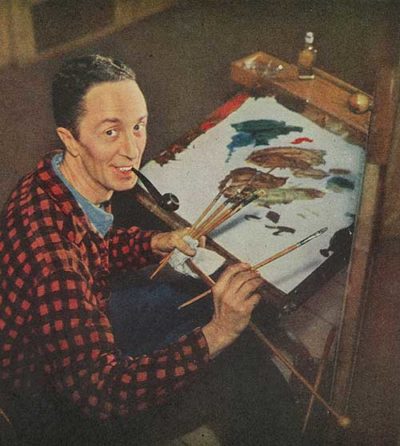
Norman Rockwell the Artist
From February 13, 1943
This photo of Rockwell appeared in the Post in 1943. By this time, the man at the easel had been doing Saturday Evening Post covers for twenty-seven years. The forties were a time of humor, anguish, the workplace, and kids being kids. This week: 1940s classics.
“The Gossips” From March 5, 1948
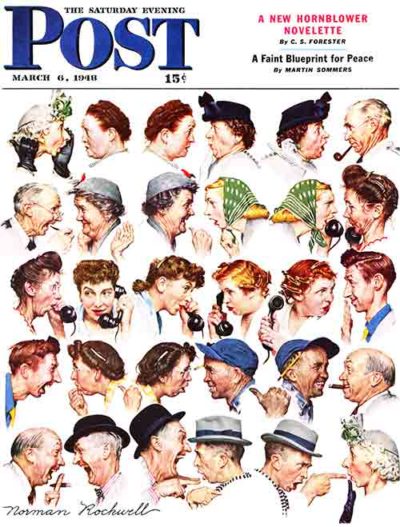
“The Gossips”
From March 5, 1948
A great illustration tells a story, and we all know this tale. Don’t you hate when someone starts a rumor about you? Well, it happened to Rockwell and he didn’t like it one bit. But he had a weapon: a paintbrush and a platform viewed by millions: The Saturday Evening Post cover spot.
It’s fun to look at the expressions: some appalled, some relishing the scandal. Afraid he might offend his neighbors/models (love the lady in curlers and the guy in the bowler hat), Rockwell included his wife and himself among the rumor spreaders. Mary Rockwell is second and third in the middle row and Norman is at the end, first with a “Who? ME?!” expression, then giving what-for to the lady who started it all.
“Rosie the Riveter” From May 29, 1943
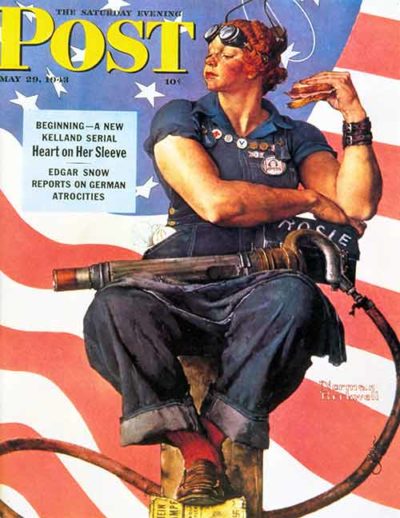
“Rosie the Riveter”
From May 29, 1943
We’ll review Rockwell’s covers from the war years soon, but for now—what can be more classic than Rosie the Riveter? With the men fighting the war, women had to step up to the plate and keep factories, farms and offices going at home and this gal looks more than capable. She may have a dirty face, muscles and a crushed copy of Hitler’s “Mein Kampf” under her sensible shoe, but she’s still a girl at heart. A compact and ladylike hanky peak out from one pocket.
“The Babysitter” From November 8, 1947
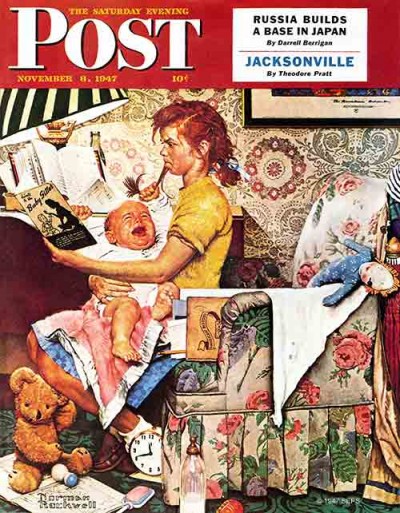
“The Babysitter”
From November 8, 1947
No babies were harmed in the creation of this cover. In fact, the baby was too darned happy. After some search, Rockwell borrowed a big, strapping baby boy to paint from a neighbor. The artist wanted a big lusty wail, but Post editors inform us that “the baby was as good-natured as a kitten full of milk; he wouldn’t even frown.” The babysitter sat and waited. The artist sat and waited. They gave the boy a cookie and the uncooperative little sod was happier than ever.
Eventually, the tot dropped the cookie and let out a brief yell. Ready with his camera, Rockwell got the shot and had a photo of a squalling kid to paint from so he could finish his artwork. It was the only peep they had out of the baby the whole time.
This is a prime example of Rockwell’s enthusiasm for detail. The attention to the minutiae of the chair pattern and wallpaper is almost enough to make the viewer dizzy. It is easy to miss items like the open geometry book and soft drink the beleaguered lass may never get back to by the lamp. And ever the storyteller, the artist shows us that nearly everything has been tried: rattles, a bottle, a bear, a doll, a coloring book. Let’s hope her booklet, “Hints to the Babysitter,” has something useful to offer—and soon!
“The Three Umpires” From April 23, 1949
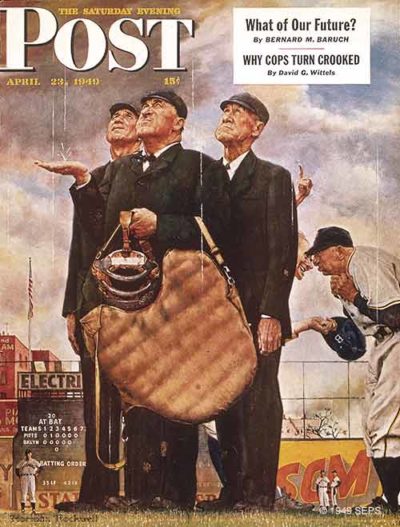
“The Three Umpires”
From April 23, 1949
There is a game riding on the weather-related decision these umpires are making. The Pittsburgh Pirates are ahead 1-0 in the sixth inning. The Brooklyn Dodgers, at home here at Ebbets Field, stand to lose if the game is called on account of rain.
Post editors speculated on the conversation between the guys to the right. They figure Brooklyn coach, Clyde Sukeforth, pointing at the sky, is declaring, “You may be all wet, but it ain’t raining a drop!” Whereas the huddled figure of Pittsburgh manager Bill Meyer is probably saying, “For the love of Abner Doubleday, how can we play ball in this cloudburst?”
“The Correct Time” From November 3, 1945
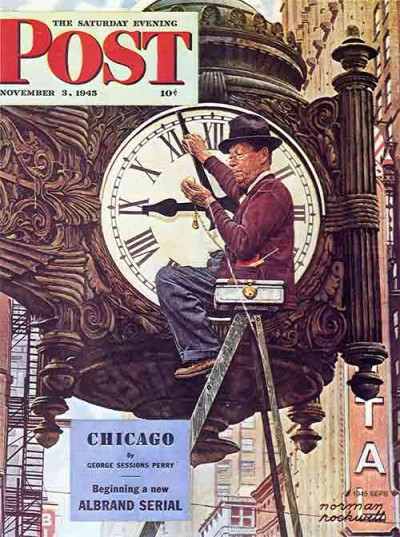
“The Correct Time”
From November 3, 1945
The giant clocks at what was then Marshall Field and Company in Chicago suggested a cover idea to a visiting gentleman named Rockwell. The two massive bronze clocks were electric and controlled by a master, so it was only after a power outage that a workman had to get out the tall ladder, climb the 17 ½ feet and set the hands. It is probably artistic license that this gent is synchronizing the time with his trusty old pocket watch.
For many years, Chicagoans have depended on the time display as they scurry back and forth. Apparently, they weren’t the only ones. To the left and above the 9, Rockwell suggests that the intricate scrollwork was also convenient for birds to build nests.
“The Dugout” From September 4,1948
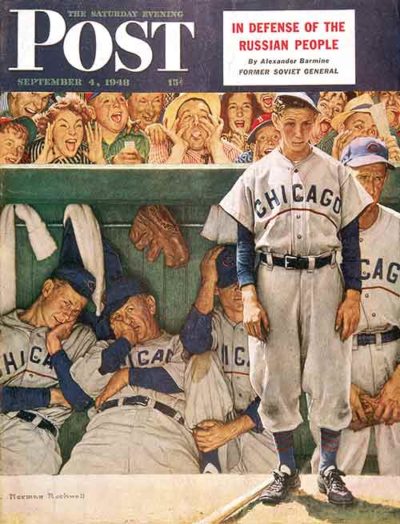
“The Dugout”
From September 4,1948
Rockwell wasn’t the only artist to paint memorable baseball covers. John Falter’s wonderful cover of Stan the Man and others can be seen in “Great Post Baseball Covers.” But “The Dugout” from 1948 has to be one of Rockwell’s classics. It wasn’t a good year for Chicago baseball, with both the Cubs and the White Sox having a dismal season. This Post cover did nothing to boost the morale of Windy City fans.
At a game in Boston, Rockwell and a Post art editor strode onto the field and chose people to sit above the Cubs’ dugout. The artist would point to a spectator and contort his face into a gleeful or disgusted look asking the fan to emulate him while a photographer snapped them. Later, Rockwell would paint them in, raspberries and all. The happy ones were, not surprisingly, Braves fans: the delighted woman to the left was the daughter of a Braves coach and the lady clutching her hands a few faces over was the wife of a Boston pitcher. (Yes, in 1948, it was the Boston Braves, before they became the Milwaukee Braves, and eventually, the Atlanta Braves.) The Cubbies were actual players (and their manager, second from left in the dugout, living up to his name: Charlie Grimm) and this was an actual Sunday afternoon double header.
Become a Saturday Evening Post member and enjoy unlimited access. Subscribe now
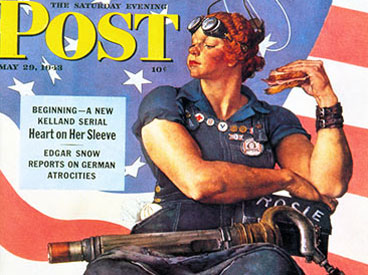

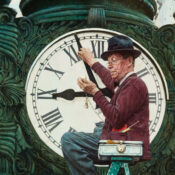
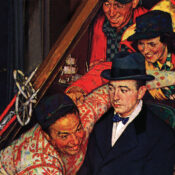
Comments
My husband and I love the Rockwell covers.
We are in our 70’s and remember the times of covers.
Thanks,
Liz & Bill
Very interesting information on some of these great covers. The trouble getting a baby to cry was quite funny – a dropped cookie would do it. The information about the fans above the dugout was quite a surprise, the wife of the Braves pitcher and daughter of a Braves coach. By Charlie Grimm in the Cubs dugout is star outfielder Andy Pafko. While the Cubs were bad in 1948, they had just been to the World Series in 1945. They haven’t been since.
It’s so great to see and be taken behind-the-scenes of some of Rockwell’s best covers of the ’40s.
‘The Gossips’ is so fascinating to study, and is a personal favorite. It also tells a timeless cautionary tale of what goes around comes around.
‘The Babysitter’ requires a lot of study in its detail and complexity. The info provided on the baby boy is a story in itself. I really wonder if he’s always had a happy disposition through life. I’ve never heard of such a happy baby before. Wow.
With ‘The Correct Time’, there are a lot of nooks and crannies to study. It’s also a reminder to me I gotta set the clocks ahead an hour tonight!
Was an avid SEP fan as a child, late twenties and the thirties.
Am a Baby boomer who have an OLD soul. Seeing great pictures from the 1940’s to 1960″s brings back memory of how simple and romantic life was back then. The Saturday Evening Post had brought this to me by sharing paintings of a legendary painter, Norman Rockwell. Without any caption, you can tell what the painting has to say. I may not be in possession or have an expensive piece of this legendary painter, but, having this published in your magazine is an honor to possess, to view and to share… Thanks!!